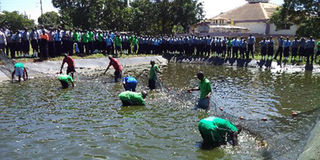A lesson on keeping fish from students

Lions High School students harvest fish at their school in Kisumu. EVERLINE OKWEO |
What you need to know:
- Peninah Oketch, the school’s principal says that they started the project last year with a capital of Sh130,000, part of which came from the county government.
- “They go to the pond in the morning and evening hours to feed the fish with assistance from their teachers. Everyone is given opportunity to learn at the pond to hone their skills.”
- The students take turns to feed the fish at 10am and 4pm. The school purchases fish feeds from an agrovet in Kisumu.
Carrying a fishnet and a bucket in his right hand, Edwin Kidas, a Form Two student at Lions Day High School in Kisumu County leads his colleagues to the institution’s fish pond.
At the pond, Nick Ochieng, their laboratory technologist hands a thermometer to one of the students to immerse in the pond water.
The student squats and holds the gadget in the water. “The temperature is 28 degrees Celsius,” he tells Ochieng who walks to him and confirms the reading.
The pond that hosts 3,000 fish is a few metres from the classrooms and has a length of 20 feet, a width of 15 feet and a depth of three feet.
“We can now embark on harvesting,” Ochieng tells the class.
He explains that it’s important to verify the temperature of the pond and that outside especially when doing partial harvesting to ensure that immature fish, if caught, do not die.
“The desired temperature inside and outside the pond should be between 26 and 35 degrees Celsius before harvesting. Over 36 degrees Celsius in the pond is not favourable for the survival of the fish, particularly tilapia. However, catfish can survive.”
It takes the students about 15 minutes to harvest the fish.
“We have captured over 2,500 fish since we started the project,” Kidas says.
Peninah Oketch, the school’s principal says that they started the project last year with a capital of Sh130,000, part of which came from the county government.
COSUME A QUARTER OF HARVEST
“Fish farming has become part and parcel of the students’ life. We consume a quarter of our harvest and sell the rest at between Sh150 and Sh250 to raise school fees for some needy students.”
According to Oketch, fish farming is a viable venture for students because it does not consume time.
“They go to the pond in the morning and evening hours to feed the fish with assistance from their teachers. Everyone is given opportunity to learn at the pond to hone their skills.”
The students take turns to feed the fish at 10am and 4pm. The school purchases fish feeds from an agrovet in Kisumu.
A 20kg bag of fish feeds goes for Sh1,200 while the same quantity of pellets at Sh1,300. The fish is also fed on food remains.
In December last year, the school harvested 2,500 fish which they sold at Sh200 each to traders. The government mixed day school made sales worth Sh300,000.
“A number of students are not able to afford fees, thus, proceeds from this project help to keep them in school. We used the money, particularly to buy food for their lunch. We hope to build more ponds to expand the project. We have enough water and land,” says Oketch.
Kidas says they also use the fish pond for agriculture and biology lessons.
“One of the things that I have learnt in fish farming is that to reduce the population of tilapia, which reproduces fast, you introduce catfish in the pond. I also know that fish farming helps in boosting food security. I hope to go into the venture when I finish school.”
George Wanjala, a researcher at the Department of Food Technology in the Kenya Industrial Research and Development Institute, says besides the nutritional and health benefits fish offer, keeping fish helps students learn how to be self-reliant and acquire agribusiness skills, particularly at this time when fish is dwindling in lakes.





